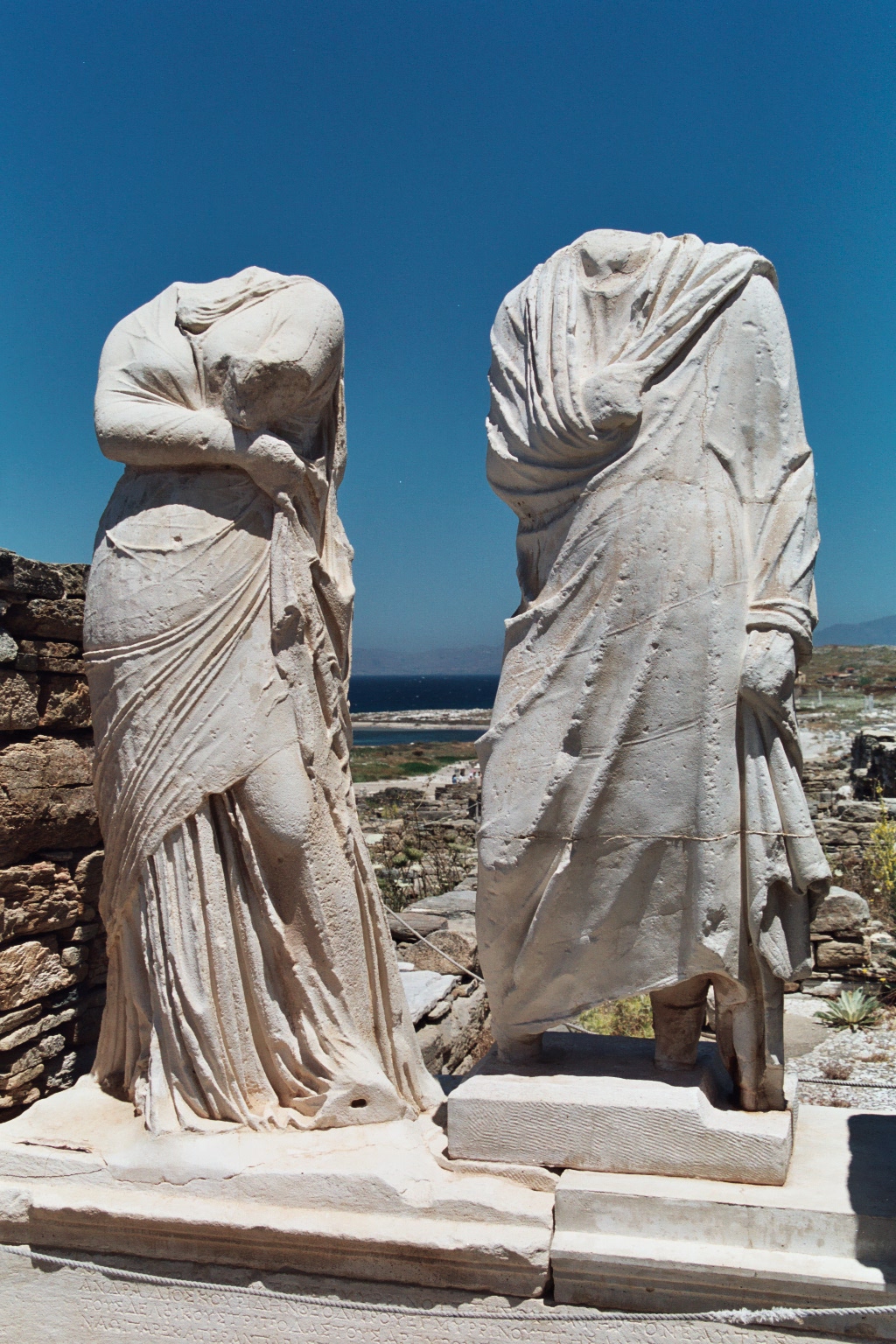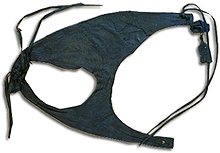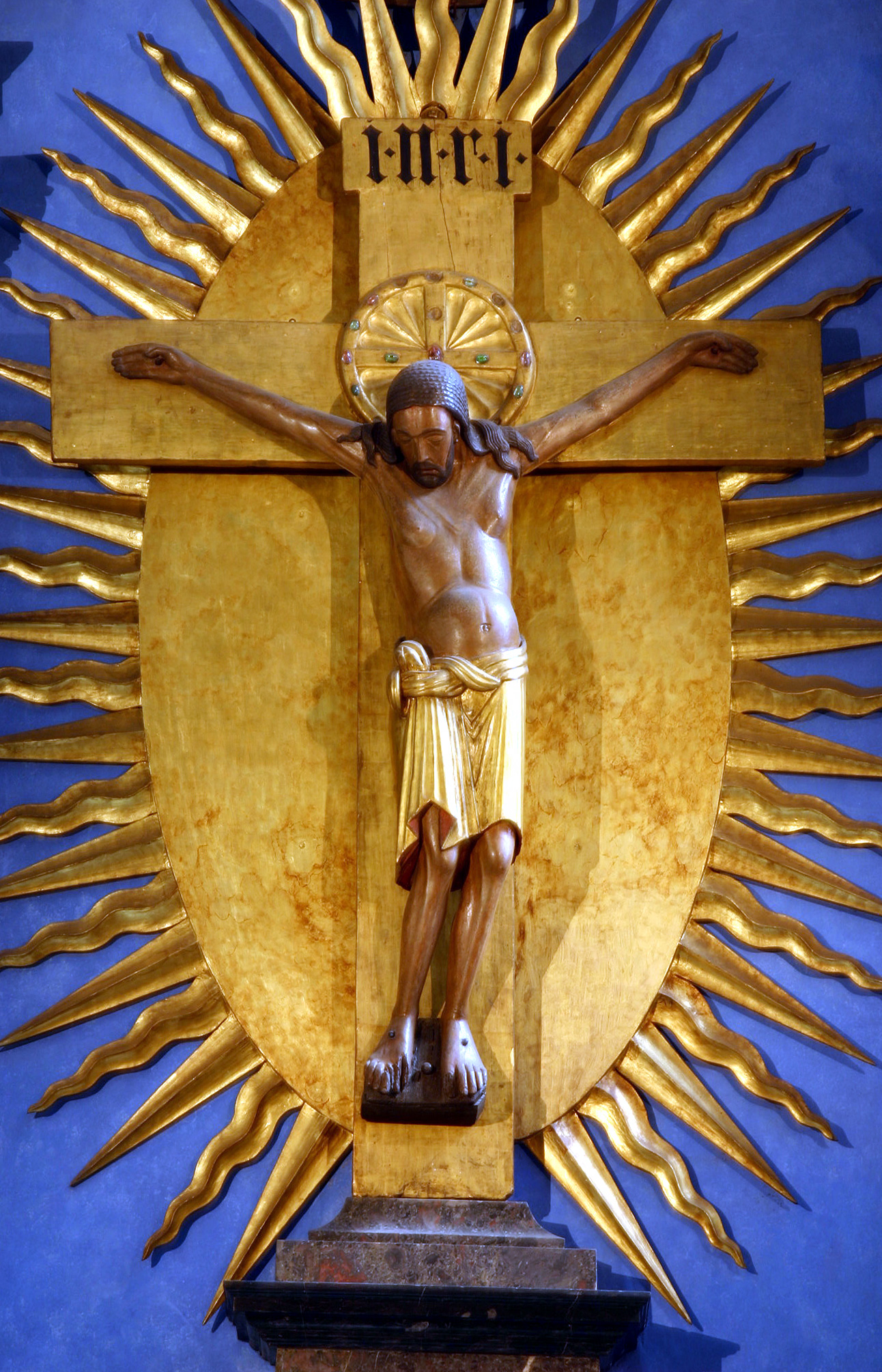|
Perizoma (loincloth)
Perizoma (from Greek , from ''peri'' "around, about" and ''zoma'' "loin-cloth, drawers, band, belt") is a type of loincloth that originated with the Minoan civilization in Crete. Surviving depictions show it being worn by male and female acrobats (for example, in the ''Bull-Leaping Fresco''). A perizoma was possibly worn by Jesus during his crucifixion. It is a standard feature of the crucifixion in the arts. However, Roman custom was to crucify victims naked, and there is no evidence to suggest that Jesus was an exception. Perizoma was likely added by later artists to preserve modesty (see fig leaf) and first appeared in the 8th century. Aachen Cathedral claims to have the actual relic of the perizoma, preserved inside the Marienschrein reliquary. See also * Subligaculum * Kaupinam The kaupinam, kaupina, langot or lungooty () is a loincloth worn by men in the Indian subcontinent as underclothing, it is now commonly worn by South Asian '' pehlwano'' wrestlers while exercisin ... [...More Info...] [...Related Items...] OR: [Wikipedia] [Google] [Baidu] |
Cristo Crucificado
Crucifixion is an ancient method of execution. Crucifixion may also refer to: * The Crucifixion or crucifixion of Jesus, a first-century AD event central to the founding and beliefs of Christianity Music * "Crucify" (song), a 1992 song by Tori Amos from ''Little Earthquakes'' * "Crucified" (Army of Lovers song) (1991) * "Crucified" (Bella & Filippa song) (2017) * "Crucifixion" (song), a 1966 song by Phil Ochs from ''Pleasures of the Harbor'' * "Crucified" (Sevendust song) (2001) * "''The Crucifixion''" (Stainer), an 1887 Passion cantata or oratorio by John Stainer *"Crucifixion" or "He Never Said a Mumblin' Word", a spiritual song *"Crucifixion", a song from the 1971 rock opera ''Jesus Christ Superstar'' by Andrew Lloyd Webber and Tim Rice *"Crucified", a 1996 song by Accept from ''Predator'' *"Crucified", a 2010 song by Disturbed from ''Asylum'' *"Crucified", a 2015 song by Venom from ''From the Very Depths'' *"Crucified", a 2017 song by Eighteen Visions from '' XVIII'' Painting ... [...More Info...] [...Related Items...] OR: [Wikipedia] [Google] [Baidu] |
Aachen Cathedral
Aachen Cathedral (german: Aachener Dom) is a Roman Catholic church in Aachen, Germany and the seat of the Roman Catholic Diocese of Aachen. One of the oldest cathedrals in Europe, it was constructed by order of Emperor Charlemagne, who was buried there in 814. From 936 to 1531, the Palatine Chapel saw the coronation of thirty-one German kings and twelve queens. The church has been the mother church of the Diocese of Aachen since 1930. In 1978, Aachen Cathedral was one of the first 12 items to be listed on the UNESCO list of World Heritage sites, because of its exceptional artistry, architecture, and central importance in the history of the Holy Roman Empire. History Charlemagne began the construction of the Palatine Chapel around 796, along with the rest of the palace structures. The construction is credited to Odo of Metz. The exact date of completion is unclear; however, a letter from Alcuin, in 798, states that it was nearing completion, and in 805, Pope Leo III consec ... [...More Info...] [...Related Items...] OR: [Wikipedia] [Google] [Baidu] |
Greek Clothing
Clothing in ancient Greece primarily consisted of the chiton, peplos, himation, and chlamys. Ancient Greek civilians typically wore two pieces of clothing draped about the body: an undergarment ( : chitōn or : péplos) and a cloak ( : himátion or : chlamýs). Ancient Greek clothing was mainly based on necessity, function, materials, and protection rather than identity. Thus, clothes were quite simple, draped, loose-fitting and free-flowing. Customarily, clothing was homemade and cut to various lengths of rectangular linen or wool fabric with minimal cutting or sewing, and secured with ornamental clasps or pins, and a belt, or girdle (: zōnē). Pieces were generally interchangeable between men and women.Adkins, Lesley, and Roy Adkins. ''Handbook to Life in Ancient Greece.'' New York: Facts On File, 1997. Print. However, women usually wore their robes to their ankles while men generally wore theirs to their knees depending on the occasion and circumstance. While no cloth ... [...More Info...] [...Related Items...] OR: [Wikipedia] [Google] [Baidu] |
Roman-era Clothing
The Roman Empire ( la, Imperium Romanum ; grc-gre, Βασιλεία τῶν Ῥωμαίων, Basileía tôn Rhōmaíōn) was the post- Republican period of ancient Rome. As a polity, it included large territorial holdings around the Mediterranean Sea in Europe, North Africa, and Western Asia, and was ruled by emperors. From the accession of Caesar Augustus as the first Roman emperor to the military anarchy of the 3rd century, it was a Principate with Italia as the metropole of its provinces and the city of Rome as its sole capital. The Empire was later ruled by multiple emperors who shared control over the Western Roman Empire and the Eastern Roman Empire. The city of Rome remained the nominal capital of both parts until AD 476 when the imperial insignia were sent to Constantinople following the capture of the Western capital of Ravenna by the Germanic barbarians. The adoption of Christianity as the state church of the Roman Empire in AD 380 and the fall ... [...More Info...] [...Related Items...] OR: [Wikipedia] [Google] [Baidu] |
Undergarments
Undergarments, underclothing, or underwear are items of clothing worn beneath outer clothes, usually in direct contact with the skin, although they may comprise more than a single layer. They serve to keep outer garments from being soiled or damaged by bodily excretions, to lessen the friction of outerwear against the skin, to shape the body, and to provide concealment or support for parts of it. In cold weather, long underwear is sometimes worn to provide additional warmth. Special types of undergarments have religious significance. Some items of clothing are designed as undergarments, while others, such as T-shirts and certain types of shorts, are appropriate both as undergarments and as outer clothing. If made of suitable material or textile, some undergarments can serve as nightwear or swimsuits, and some are intended for sexual attraction or visual appeal. Undergarments are generally of two types, those that are worn to cover the torso and those that are worn to cover ... [...More Info...] [...Related Items...] OR: [Wikipedia] [Google] [Baidu] |
Kaupinam
The kaupinam, kaupina, langot or lungooty () is a loincloth worn by men in the Indian subcontinent as underclothing, it is now commonly worn by South Asian '' pehlwano'' wrestlers while exercising or sparring in a '' dangal''. It is made up of a rectangular strip of cotton cloth used to cover the genitals with the help of the strings, connected to the four ends of the cloth for binding it around the waist. The small ''lungooty'' worn by naga sadhus or fakirs is also known as ''Coopees''. Use It is used extensively by wrestlers (''pehelwans'') in India participating in the traditional game of ''Pehlwani'' (a form of traditional wrestling). It is worn by wrestlers during matches, practice, training and exercises (''kasrat''). The kaupinam in India is the traditional male sports gear associated with almost every form of physically straining sports like kushti and ''kabaddi''. It has been worn by sportsmen and bodybuilders during training and exercise sessions (similar to the con ... [...More Info...] [...Related Items...] OR: [Wikipedia] [Google] [Baidu] |
Subligaculum
A ''subligaculum'' was a kind of undergarment worn by ancient Romans. It could come either in the form of a pair of shorts, or in the form of a simple loincloth wrapped around the lower body. It could be worn both by men and women. In particular, it was part of the dress of gladiators, athletes, and of actor An actor or actress is a person who portrays a character in a performance. The actor performs "in the flesh" in the traditional medium of the theatre or in modern media such as film, radio, and television. The analogous Greek term is (), l ...s on the stage. Leather ''subligacula'' have been found in excavations of 1st century Roman London. The longer-form ''subligaculum'' that forms a loin cloth is tied as follows: First, the strings are tied around the waist with the long part hanging down back, covering the buttocks. Next, the long part is brought down between the legs and pulled up behind the knot tied in front. Then it is draped over the ties so it forms a ... [...More Info...] [...Related Items...] OR: [Wikipedia] [Google] [Baidu] |
Marienschrein
The Marienschrein (Shrine of Mary) in Aachen Cathedral is a reliquary, donated on the order of the chapter of Mary around 1220 and consecrated in 1239. Along with the Karlsschrein, the artwork, which is from the transitional period between romanesque and gothic, is among the most important goldsmith works of the thirteenth century. Function The shrine serves as the container of the four great contact relics and objects of pilgrimage in Aachen Cathedral. The relics include: the swaddling clothes and loin cloth of Jesus, the dress of Mary and the decapitation cloth of John the Baptist, which have been shown to the congregation and to pilgrims participating in the Aachen pilgrimage every seven years since plague struck in 1349. Until the nineteenth century, it was also the container for the '' Noli me tangere'' casket, a silver-gilt casket with mysterious contents. Form The shrine takes the form of a single-naved basilica with a short transept. More than a thousand gemstone ... [...More Info...] [...Related Items...] OR: [Wikipedia] [Google] [Baidu] |
Fig Leaf
The expression "fig leaf" is widely used figuratively to convey the covering up of an act or an object that is embarrassing or distasteful with something of innocuous appearance, a metaphorical reference to the Biblical Book of Genesis in which Adam and Eve used fig leaves to cover their nudity after eating the forbidden fruit from the tree of the knowledge of good and evil. Some paintings and statues have the genitals of their subjects covered by a representation of an actual fig leaf or similar object, either as part of the work or added afterward for perceived modesty. History In Ancient Greek art, male nakedness, including the genitals, was common, although the female vulval area was generally covered in art for public display. This tradition continued in Ancient Roman art until the conversion of the Roman Empire to Christianity, when heroic nudity vanished. During the Middle Ages, only the unfortunate (most often the damned) were usually shown naked, although the dep ... [...More Info...] [...Related Items...] OR: [Wikipedia] [Google] [Baidu] |
Greek Language
Greek ( el, label= Modern Greek, Ελληνικά, Elliniká, ; grc, Ἑλληνική, Hellēnikḗ) is an independent branch of the Indo-European family of languages, native to Greece, Cyprus, southern Italy (Calabria and Salento), southern Albania, and other regions of the Balkans, the Black Sea coast, Asia Minor, and the Eastern Mediterranean. It has the longest documented history of any Indo-European language, spanning at least 3,400 years of written records. Its writing system is the Greek alphabet, which has been used for approximately 2,800 years; previously, Greek was recorded in writing systems such as Linear B and the Cypriot syllabary. The alphabet arose from the Phoenician script and was in turn the basis of the Latin, Cyrillic, Armenian, Coptic, Gothic, and many other writing systems. The Greek language holds a very important place in the history of the Western world. Beginning with the epics of Homer, ancient Greek literature includes many works of l ... [...More Info...] [...Related Items...] OR: [Wikipedia] [Google] [Baidu] |
Crucifixion In The Arts
Crucifixions and crucifixes have appeared in the arts and popular culture from before the era of the pagan Roman Empire. The crucifixion of Jesus has been depicted in a wide range of religious art since the 4th century CE, much of which has included the appearance of mournful onlookers, the Virgin Mary, angels, Pontius Pilate and even antisemeitc depictions of diecidal Jews. In more modern times, crucifixion has appeared in film and television as well as in fine art, and depictions of other historical crucifixions have appeared as well as the crucifixion of Christ. Modern art and culture have also seen the rise of images of crucifixion being used to make statements unconnected with Christian iconography, or even just used for shock value. Art Late Antiquity The earliest known artistic representations of crucifixion predate the Christian era, including Greek representations of mythical crucifixions inspired by the use of the punishment by the Persians. The Alexamenos ... [...More Info...] [...Related Items...] OR: [Wikipedia] [Google] [Baidu] |
Jesus
Jesus, likely from he, יֵשׁוּעַ, translit=Yēšūaʿ, label=Hebrew/Aramaic ( AD 30 or 33), also referred to as Jesus Christ or Jesus of Nazareth (among other names and titles), was a first-century Jewish preacher and religious leader; he is the central figure of Christianity, the world's largest religion. Most Christians believe he is the incarnation of God the Son and the awaited Messiah (the Christ) prophesied in the Hebrew Bible. Virtually all modern scholars of antiquity agree that Jesus existed historically. Research into the historical Jesus has yielded some uncertainty on the historical reliability of the Gospels and on how closely the Jesus portrayed in the New Testament reflects the historical Jesus, as the only detailed records of Jesus' life are contained in the Gospels. Jesus was a Galilean Jew who was circumcised, was baptized by John the Baptist, began his own ministry and was often referred to as "rabbi". Jesus debated with fellow ... [...More Info...] [...Related Items...] OR: [Wikipedia] [Google] [Baidu] |









